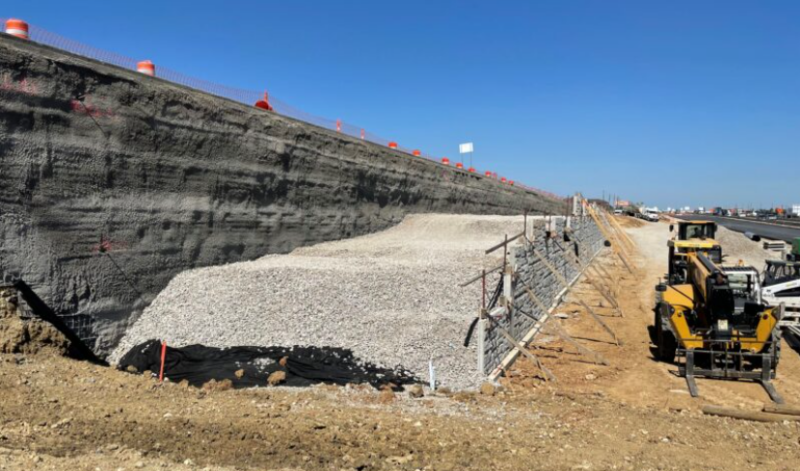Earth pressure and Earth Retaining Systems
Online course |
|
50 hours / 6 weeks |
|
|
Dates: 20th of May to 1st of July |
| Standard | Unemployed Or Student |
| $400 | $302 |
Introduction
Earth retaining systems (or retaining walls) are used to hold back earth and maintain a difference in the elevation of the ground surface in a wide variety of applications from highway construction to commercial and residential projects.
Since in general, the cost of constructing a retaining wall is usually high compared with the cost of forming a new slope, the need for a retaining wall should be assessed carefully during design to provide the most efficient retaining system in terms of cost and benefit.
The purpose of this course is to provide the practicing engineer with a thorough understanding of various retaining walls and their application in infrastructure construction.
Objectives
The course intends to provide the fundamental concepts for the analysis and design of most used earth retaining systems, including cast-in-place reinforced concrete walls, sheet pile walls, mechanically stabilized earth (MSE) walls and soil nail walls.
Limited places.
Module 1: Active, passive and at-rest earth pressures cases
– Coulomb
– Rankine
– Müller-Breslau
– Monobe-Okabe
– Terzaghi
– Jaky
– Mayne-Kulhawy
– Practical exercise
Module 2: Classification of earth-retaining systems and factors affecting earth pressure
– Externally stabilized systems: in-situ and gravity walls
– Internally stabilized systems: Reinforced soils and in-situ reinforcement
– Water and retaining systems
– Preliminary selection of wall type
– Practical exercise
Module 3: Cast-in-place reinforced concrete walls
– Types of semi-gravity CIP walls
– Design Steps
– Practical exercise
Module 4: Sheet pile walls
– Cantilever sheet-pile walls
– Singly anchored sheet-pile walls
– Practical exercise
Module 5: Mechanically stabilized earth (MSE) walls
– Applications of MSE walls
– Strength and service limit states
– Practical exercise
Module 6: Soil nail walls
– Charts for Preliminary Design
– External Stability
– Internal Stability
– Practical exercise
Alejandro H. Pino Bravo
Alejandro H. Pino Bravo graduated from Universidad del Cauca, Colombia, with a Bachelor of Sciences Degree in Civil Engineering in 2001 and obtained the degree of specialist in geotechnical engineering from the Universidad Nacional de Colombia in 2007.
In 2012 joined the University of Texas at Arlington (UTA) to pursue a Master of Science degree in Civil Engineering and in 2016, he graduated from his doctoral program with Geotechnical Engineering as the research concentration area in the Department of Civil Engineering at the University of Texas at Arlington (UTA) in Arlington, Texas.
From his experience of 4 years as a researcher, he has gained strong analytical skills and knowledge in saturated and unsaturated soil mechanics, including conventional and advanced material testing (consolidometer – consolidation/expansion-, triaxial, direct shear, resonant column, bender element and ring shear devices, among others).
As a practitioner engineer for more than 15 years with consulting and construction companies in Colombia, Ecuador and the United States of America, he has a vast experience handling geotechnical (soil and rock mechanics) and structural aspects of infrastructure projects (design and construction of highways and roads as well as commercial and residential projects).
His software skills for geotechnical analysis and design include (among others): GSTABL7, GEOSTUDIO SUITE, SLIDE, SETTLE 3D, DIPS, PLAXIS, APILE, LPILE, SHAFT, PYWALL, SNAIL, SNAILZWIN, MSEW
Alejandro H. Pino Bravo graduated from Universidad del Cauca, Colombia, with a Bachelor of Sciences Degree in Civil Engineering in 2001 and obtained the diploma of specialist in geotechnical engineering from the Universidad Nacional de Colombia in 2007.
In 2012 joined the Department of Civil Engineering at the University of Texas at Arlington (UTA) in Arlington, Texas to pursue a Master of Science degree in Civil Engineering and a doctoral program both with Geotechnical Engineering as the research concentration area.
From his experience of 4 years as a researcher at UTA, he has gained strong analytical skills and knowledge in saturated and unsaturated soil mechanics, including conventional and advanced material testing (consolidometer – consolidation/expansion-, triaxial, direct shear, resonant column, bender element and ring shear devices, among others).
Licensed professional engineer in Colombia y Texas (USA), he has more than 15 years working with consulting and construction companies in Colombia, Ecuador and the United States of America. His vast experience includes handling geotechnical (soil and rock mechanics) and structural aspects of infrastructure projects (design and construction of highways and roads, ports, as well as commercial and residential projects).
The course is delivered online through our easy-to-use Virtual Campus platform. For this course, a variety of content is provided including:
– eLearning materials
– Videos
– Interactive multimedia content
– Live webinar classes
– Texts and technical articles
– Case studies
– Assignments and evaluation exercises
We regularly update this course to ensure the latest news and state-of-the-art developments are covered, and your knowledge of the subject is current.
Live webinars form part of our course delivery. These allow students and tutors to go through the course materials, exchange ideas and knowledge, and solve problems together in a virtual classroom setting. Students can also make use of the platform’s forum, a meeting point to interact with tutors and other students.
The tutoring system is managed by email. Students can email the tutor with any questions about the course and the tutor will be happy to help.
The course structure allows it to be easily adapted to the needs of different student profiles, among which it can be highlighted:
Professionals involved in projects with mid-to-high geotechnical component and any level of ground complexity. Consequently, the course will provide useful resources for both structural and geotechnical designers/consultants and for engineers responsible for work execution, management, or quality control. The course will provide theoretical and practical knowledge about earth pressures and retaining structures required to appropriately design these structures in a correct technical, constructive, and economic manner.
Senior university students or recent graduates of civil engineering, geology or related fields who aim to expand their knowledge in soil and rock mechanics applied to the design of retaining structures.
Once a student finishes the course and successfully completes the assignments and evaluation tests, they are sent an accreditation certificate. The certificate is issued by Ingeoexpert to verify that the student has passed the course. It is a digital certificate that is unique and tamper-proof – it is protected by Blockchain technology. This means it is possible for anyone to check that it is an authentic, original document.
You will be able to download the certificate in an electronic format from the Virtual Campus platform. The certificate can be forwarded by email, shared on social networks, and embedded on websites. To see an example, click here.
The objective of the course is not only to offer the student a theoretical and practical background in analysis of earth pressures and retaining structures design, but it will also allow them to become familiar with the multidisciplinary nature of this field. Therefore, the course will allow professionals who have already had experience in this field and want to acquire proficiency in the earth pressures evaluation and retaining structures design, both on a theoretical and practical level. At the same time, for those students who have not had much prior background in geotechnical engineering, the course will allow them to expand their curricular itinerary in this field, expanding the potential of their professional profile.
Since in the recent years, the consulting and construction companies are looking for professionals with expertise in the field, we aim that this course can reach job opportunities for students in this demanding and interesting field.
Introduction
Earth retaining systems (or retaining walls) are used to hold back earth and maintain a difference in the elevation of the ground surface in a wide variety of applications from highway construction to commercial and residential projects.
Since in general, the cost of constructing a retaining wall is usually high compared with the cost of forming a new slope, the need for a retaining wall should be assessed carefully during design to provide the most efficient retaining system in terms of cost and benefit.
The purpose of this course is to provide the practicing engineer with a thorough understanding of various retaining walls and their application in infrastructure construction.
Objectives
The course intends to provide the fundamental concepts for the analysis and design of most used earth retaining systems, including cast-in-place reinforced concrete walls, sheet pile walls, mechanically stabilized earth (MSE) walls and soil nail walls.
Limited places.
Module 1: Active, passive and at-rest earth pressures cases
– Coulomb
– Rankine
– Müller-Breslau
– Monobe-Okabe
– Terzaghi
– Jaky
– Mayne-Kulhawy
– Practical exercise
Module 2: Classification of earth-retaining systems and factors affecting earth pressure
– Externally stabilized systems: in-situ and gravity walls
– Internally stabilized systems: Reinforced soils and in-situ reinforcement
– Water and retaining systems
– Preliminary selection of wall type
– Practical exercise
Module 3: Cast-in-place reinforced concrete walls
– Types of semi-gravity CIP walls
– Design Steps
– Practical exercise
Module 4: Sheet pile walls
– Cantilever sheet-pile walls
– Singly anchored sheet-pile walls
– Practical exercise
Module 5: Mechanically stabilized earth (MSE) walls
– Applications of MSE walls
– Strength and service limit states
– Practical exercise
Module 6: Soil nail walls
– Charts for Preliminary Design
– External Stability
– Internal Stability
– Practical exercise
Alejandro H. Pino Bravo
Alejandro H. Pino Bravo graduated from Universidad del Cauca, Colombia, with a Bachelor of Sciences Degree in Civil Engineering in 2001 and obtained the degree of specialist in geotechnical engineering from the Universidad Nacional de Colombia in 2007.
In 2012 joined the University of Texas at Arlington (UTA) to pursue a Master of Science degree in Civil Engineering and in 2016, he graduated from his doctoral program with Geotechnical Engineering as the research concentration area in the Department of Civil Engineering at the University of Texas at Arlington (UTA) in Arlington, Texas.
From his experience of 4 years as a researcher, he has gained strong analytical skills and knowledge in saturated and unsaturated soil mechanics, including conventional and advanced material testing (consolidometer – consolidation/expansion-, triaxial, direct shear, resonant column, bender element and ring shear devices, among others).
As a practitioner engineer for more than 15 years with consulting and construction companies in Colombia, Ecuador and the United States of America, he has a vast experience handling geotechnical (soil and rock mechanics) and structural aspects of infrastructure projects (design and construction of highways and roads as well as commercial and residential projects).
His software skills for geotechnical analysis and design include (among others): GSTABL7, GEOSTUDIO SUITE, SLIDE, SETTLE 3D, DIPS, PLAXIS, APILE, LPILE, SHAFT, PYWALL, SNAIL, SNAILZWIN, MSEW
Alejandro H. Pino Bravo graduated from Universidad del Cauca, Colombia, with a Bachelor of Sciences Degree in Civil Engineering in 2001 and obtained the diploma of specialist in geotechnical engineering from the Universidad Nacional de Colombia in 2007.
In 2012 joined the Department of Civil Engineering at the University of Texas at Arlington (UTA) in Arlington, Texas to pursue a Master of Science degree in Civil Engineering and a doctoral program both with Geotechnical Engineering as the research concentration area.
From his experience of 4 years as a researcher at UTA, he has gained strong analytical skills and knowledge in saturated and unsaturated soil mechanics, including conventional and advanced material testing (consolidometer – consolidation/expansion-, triaxial, direct shear, resonant column, bender element and ring shear devices, among others).
Licensed professional engineer in Colombia y Texas (USA), he has more than 15 years working with consulting and construction companies in Colombia, Ecuador and the United States of America. His vast experience includes handling geotechnical (soil and rock mechanics) and structural aspects of infrastructure projects (design and construction of highways and roads, ports, as well as commercial and residential projects).
The course is delivered online through our easy-to-use Virtual Campus platform. For this course, a variety of content is provided including:
– eLearning materials
– Videos
– Interactive multimedia content
– Live webinar classes
– Texts and technical articles
– Case studies
– Assignments and evaluation exercises
We regularly update this course to ensure the latest news and state-of-the-art developments are covered, and your knowledge of the subject is current.
Live webinars form part of our course delivery. These allow students and tutors to go through the course materials, exchange ideas and knowledge, and solve problems together in a virtual classroom setting. Students can also make use of the platform’s forum, a meeting point to interact with tutors and other students.
The tutoring system is managed by email. Students can email the tutor with any questions about the course and the tutor will be happy to help.
The course structure allows it to be easily adapted to the needs of different student profiles, among which it can be highlighted:
Professionals involved in projects with mid-to-high geotechnical component and any level of ground complexity. Consequently, the course will provide useful resources for both structural and geotechnical designers/consultants and for engineers responsible for work execution, management, or quality control. The course will provide theoretical and practical knowledge about earth pressures and retaining structures required to appropriately design these structures in a correct technical, constructive, and economic manner.
Senior university students or recent graduates of civil engineering, geology or related fields who aim to expand their knowledge in soil and rock mechanics applied to the design of retaining structures.
Once a student finishes the course and successfully completes the assignments and evaluation tests, they are sent an accreditation certificate. The certificate is issued by Ingeoexpert to verify that the student has passed the course. It is a digital certificate that is unique and tamper-proof – it is protected by Blockchain technology. This means it is possible for anyone to check that it is an authentic, original document.
You will be able to download the certificate in an electronic format from the Virtual Campus platform. The certificate can be forwarded by email, shared on social networks, and embedded on websites. To see an example, click here.
The objective of the course is not only to offer the student a theoretical and practical background in analysis of earth pressures and retaining structures design, but it will also allow them to become familiar with the multidisciplinary nature of this field. Therefore, the course will allow professionals who have already had experience in this field and want to acquire proficiency in the earth pressures evaluation and retaining structures design, both on a theoretical and practical level. At the same time, for those students who have not had much prior background in geotechnical engineering, the course will allow them to expand their curricular itinerary in this field, expanding the potential of their professional profile.
Since in the recent years, the consulting and construction companies are looking for professionals with expertise in the field, we aim that this course can reach job opportunities for students in this demanding and interesting field.
Solicita información del webinar
Completa este webinar y obtén el certificado de:
Earth pressure and Earth Retaining Systems

Earth pressure and Earth Retaining Systems
| $400 | $302 | |
| Get more information |





Reviews
There are no reviews yet.